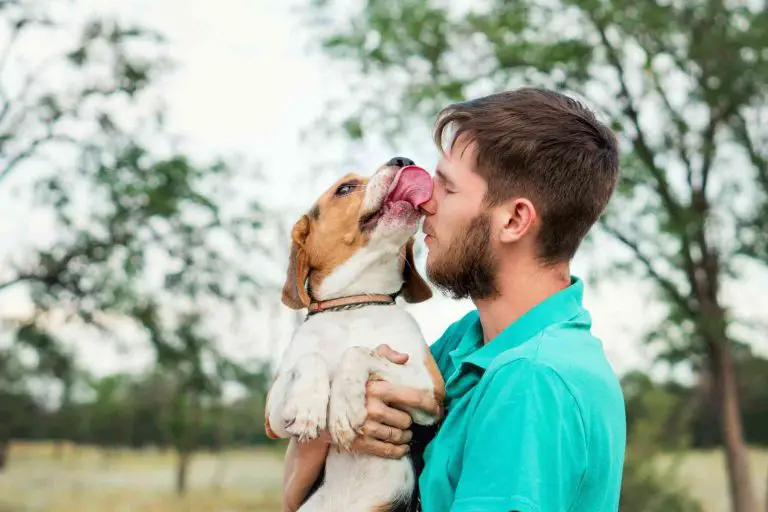How Much Water Should a Dog Drink? (Including Useful Rule of Thumb)

As a responsible dog owner, it’s essential to know how much water your furry companion should be consuming on a daily basis. Ensuring that your dog stays well-hydrated not only contributes to their overall health but also prevents potential health issues that could arise due to dehydration or overhydration.
Factors that can influence a dog’s water intake include their size, age, activity level, and weather conditions. It’s crucial to understand the role these factors play in determining the appropriate amount of water for your specific pet to guarantee their well-being.
Generally, the recommended water intake for dogs is one ounce of water per pound of body weight daily.
Rule of thumb
However, individual circumstances may warrant adjustments to this guideline, which is why it’s important for owners to monitor their dog’s hydration levels and adjust the water intake accordingly.
Factors Affecting Water Intake
Various factors influence the amount of water a dog should drink. It is crucial to be aware of these factors to ensure proper hydration and maintain your dog’s overall health. This section covers the most common factors affecting water intake, including body weight and age, activity level, breed, health and medical conditions, diet and food type, and weather and ambient temperature.
1. Body Weight and Age
A dog’s body weight and age play an essential role in determining water intake. In general, a dog needs to drink about one ounce of water per pound of body weight daily. Puppies and older dogs tend to consume more water, as puppies require hydration for growth and development, while older dogs may experience decreased kidney function, making them prone to dehydration.
2. Activity Level
The activity level of a dog also affects how much water it needs. Active dogs will require more water compared to sedentary dogs due to increased body temperature and potential water loss through panting and sweating. It is vital to provide easy access to clean water, especially after a play session or a walk.
3. Breed
Some dog breeds may have a predisposition to drink more or less water due to their physiological differences. Breeds with thicker coats may, for example, require more water to regulate their body temperature. It is essential to research your dog’s breed-specific needs or consult a veterinarian for guidance.
4. Health and Medical Conditions
Health and medical conditions can significantly impact a dog’s water intake. Dogs with diabetes or kidney disease may drink more, while certain infections or illnesses may cause a loss of appetite and decreased water consumption. It is vital to monitor your dog’s water intake and consult your veterinarian if you notice any abrupt changes.
5. Diet and Food Type
The type of food your dog eats can also affect water intake. Wet food typically contains more moisture than dry kibble, which means dogs on a wet food diet may drink less water. On the other hand, dry kibble can increase a dog’s thirst, leading to a higher water consumption. Always ensure fresh water is available, regardless of your dog’s diet.
6. Weather and Ambient Temperature
Weather and ambient temperature significantly influence a dog’s water intake. During hot or humid conditions, dogs may consume more water to cool down and prevent dehydration. It is crucial to keep an eye on your dog’s water consumption and provide access to clean water, especially during extreme weather conditions.
How Much Water Should a Dog Drink
Determining the appropriate amount of water a dog should drink daily depends on various factors such as age, size, activity level, and overall health. This section provides general guidelines, as well as specific information for puppies, active dogs, and pregnant or lactating dogs.
General Guidelines
As a basic guideline, dogs should drink about an ounce of water per pound of body weight each day. To calculate this, simply multiply your dog’s weight by 1 ounce (for example: 40 lbs x 1 oz = 40 oz of water daily). Keep in mind that this is a rough estimate and individual needs may vary.
Specific Needs for Puppies
Puppies typically require more water (per pound body weight) than adult dogs due to their rapid growth and development. It’s essential to ensure they have access to clean, fresh water at all times. Monitor their intake and adjust it as needed, taking into consideration factors such as size, breed, and energy level.
Active Dogs
Active dogs, such as those participating in sports or other physical activities, require more water to stay hydrated and maintain optimal health. Be sure to provide access to water during exercise, and monitor their intake for any signs of dehydration, such as excessive panting or lethargy.
Pregnant or Lactating Dogs
Similar to active dogs, pregnant or lactating dogs need additional water to support their body’s changing needs. During pregnancy, it’s essential to ensure your dog receives enough water, as it aids in fetal development. Lactating dogs require even more water to support milk production, sometimes up to three times the normal amount. Ensure they have access to fresh, clean water at all times and pay attention to their intake.
Signs of Dehydration and Overhydration
It is crucial for dog owners to be able to recognize the signs of both dehydration and overhydration in their pets. This section will cover the symptoms and methods to detect dehydration and overhydration, as well as the diagnosis and treatment for these conditions.
Detecting Dehydration
Dehydration in dogs can occur if the dog loses more water than it takes in. Dogs can become dehydrated for various reasons, including illness, vomiting, or diarrhea. Some common signs of dehydration include:
- Loss of skin elasticity
- Sunken eyeballs
- Thick saliva
- Decreased energy levels
A simple way to check for dehydration is to gently lift the dog’s skin between the shoulder blades. If the skin snaps back quickly, the dog is likely well-hydrated. However, if the skin takes a while to return to its normal position, the dog may be dehydrated.
Detecting Overhydration
Overhydration, or water intoxication, happens when a dog consumes too much water too quickly. This can lead to an imbalance in electrolytes, causing various health issues. Signs of overhydration include:
- Vomiting
- Excessive urination
- Swelling or bloating
- Difficulty breathing
Overhydration can be dangerous, so it is important to monitor your dog’s water intake and behavior, especially during activities involving water, such as swimming or playing with a hose.
Diagnosis and Treatment
If you suspect dehydration or overhydration, it is crucial to consult a veterinarian immediately. They can accurately diagnose the issue through a physical examination and, if necessary, blood tests. It is important not to try and self-diagnose or treat your dog at home, as it could potentially lead to more severe health problems.
Treatment for dehydration may involve rehydration solutions or intravenous fluids, depending on the severity of the condition. In cases of overhydration, the veterinarian may recommend reducing water intake, monitoring electrolyte levels, or providing medications to help balance the dog’s electrolytes.
Tips to Encourage Water Consumption
Keeping your dog hydrated is essential for overall health, body temperature regulation, and maintaining joint health. By offering accessible water sources, incorporating flavored broths and ice cubes, and investing in a water fountain, you can effectively increase your dog’s water consumption. Here is how to encourage your dog in drinking an adequate amount of fluids.
Offering Accessible Water Sources
Ensure your dog has multiple water sources available in different areas throughout your home. Keep the water bowls clean and always filled with fresh water. By offering various accessible points for hydration, you provide an opportunity for your dog to drink more water, ensuring they remain hydrated throughout the day.
Using Flavored Broths and Ice Cubes
Incorporating flavor enhancements to the water can entice your dog to drink more. Mixing water with the low-sodium chicken or bone broth offers an appealing taste without additional sodium or chemicals that may be harmful to your dog. These nutrient-rich broths can be frozen into ice cubes, offering a cooling treat on hot days or blended with canned food to augment their daily fluid intake.
Note: Always consult your veterinarian before adding any new supplements or food items to your dog’s diet.
Investing in a Water Fountain
Water fountains can be an attractive solution for pet parents in increasing their dog’s water consumption. The constant flow of water not only keeps the water oxygenated and fresh but also entices your dog to drink more frequently. By providing a separate source of water and filtration, you can ensure your dog maintains proper fluid intake, contributing to overall health and wellness.
Preventative Measures and Monitoring
Maintaining your dog’s health and ensuring proper water intake is crucial for preventing dehydration and other health issues. This section covers various preventative measures and monitoring techniques to help maintain your dog’s overall health.
Regular Veterinary Check-ups
Regular veterinary check-ups are essential for monitoring your dog’s health, detecting potential issues early, and maintaining an optimal water intake. Veterinarians can assess your dog’s hydration status, electrolyte balance, and identify any underlying health conditions such as diabetes mellitus or kidney disease that may affect water consumption.
During a check-up, the veterinarian may also evaluate other factors such as body temperature, liver function, and the health of vital organs. These assessments can identify potential risks and provide guidance to help you adjust your dog’s water intake accordingly.
Observing Changes in Drinking and Urination Patterns
Monitoring your dog’s drinking and urination patterns can provide valuable insights into their health and water intake. The normal water intake for dogs can vary depending on factors such as age, activity level, and ambient temperature. However, if you notice your dog drinking more than usual, it may be a sign of an underlying issue such as diabetes insipidus, Cushing’s disease, or cancer.
Changes in urine frequency, color, or odor can also indicate potential health concerns. For instance, dark-colored or strong-smelling urine may signal dehydration or infection. Keeping track of your dog’s urination patterns can help you maintain a balanced electrolyte and hydration status.
Adjusting Water Intake for Specific Circumstances
Different circumstances may require adjustments to your dog’s water intake. For example, active dogs, pregnant, or lactating dogs need more water than their sedentary counterparts. Additionally, dogs that primarily consume dry kibble may require more water due to the lower moisture content in their food.
Temperature also plays a role, with dogs needing more water during hot weather to regulate body temperature and maintain hydration. Be vigilant to ensure your dog has accessible clean water at all times, and consider using water fountains or regularly washing water bowls with soap and water to maintain cleanliness.






